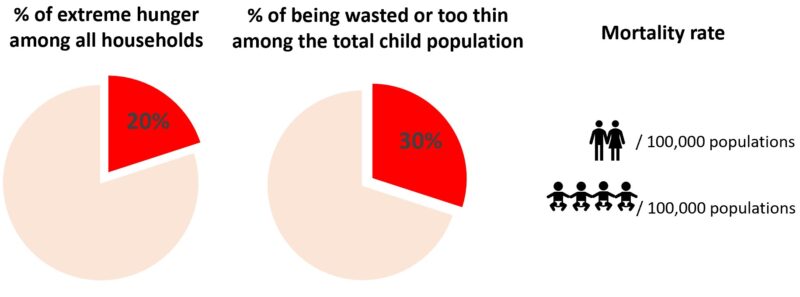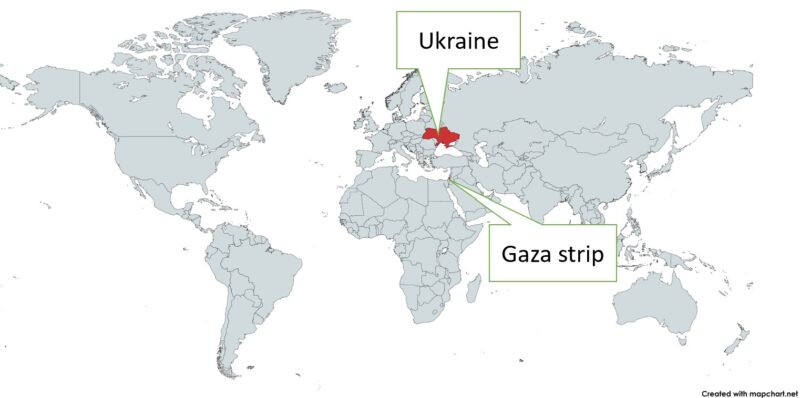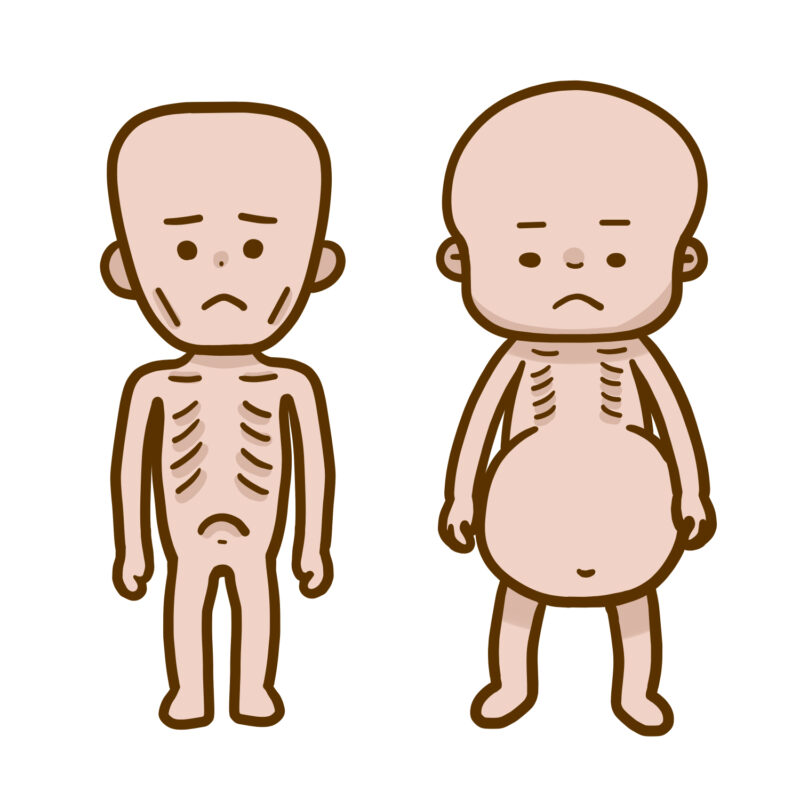
What is a man-made famine?
First, let’s check the definition of “Famine”.
Famine defines the situation in which people face malnutrition and hunger-related deaths due to the lack of food, with the following three conditions in a particular area:
- At least 20% of households face extreme hunger;
- 30% of children are wasted or too thin; and
- The mortality rate reaches 2/100,000 populations for adults and 4/100,000 populations for children every day

One cause of famine occurs when someone intentionally stops food distribution to others during wars.
We call it a man-made famine.
Historically, it happened in 1932ー1933 in Ukraine, which is called Holodomor.
It was carried out by the Starlin’s regime in the Soviet Union and resulted in the deaths of millions.
Currently, people living in the Gaza Strip are facing extreme food shortages. All supply distribution including food has been obstructed due to the Israel-Hamas war.

According to the Famine Review Committee (FRC) of the Integrated Food Security Phase Classification (IPC), 95% of the population in Gaza (2,130,000 populations) was under food catastrophic, emergency, or crisis in March 2024, and the entire population is expected to suffer from hunger by June 2024.


Hmm, humans are pretty cruel to intentionally stop food distribution…
Cats wouldn’t do such mean things.

What kind of international laws address food supply and a man-made famine?
The Right to Food is one of Human Rights we have, defined by several international laws, such as the Universal Declaration of Human Rights, the International Covenant on Economic, Social, and Cultural Rights, and the Convention on the Rights of the Child.
State parties must protect the following points through the International Covenant on Economic, Social, and Cultural Rights.
(1) Recognise the right to an adequate standard of living including adequate food;
(2) Recognise the fundamental right to be free from hunger; and
(3) Ensure an equitable distribution of world food supply.
Those are legal obligations to state parties.
During wars, International Humanitarian Law (IHL) protects access to food and water to civilians and prisoners of war.
Intentional starvation of civilians is prohibited by IHL.
Violations of this are considered war crimes.


When countries start ignoring international law, the world will lose balance and only conflict and chaos will remain.
We must avoid such a situation. We must all respect humanitarian law and uphold morality for peace and order.

What happens to our bodies by starvation?
Starvation is one form of Protein-Energy Undernutrition (PEU).
Symptoms of PEU vary depending on the severity of the nutrient deficiency (mild, moderate, severe), how quickly it progresses (acute, chronic), and the age of the patient (child, adult).
Starvation occurs acutely and severely due to lacking all nutrients.
The major symptoms are as follows:
- Weight loss
- Fat and muscle wasting
- Abnormal vital signs: low blood pressure, slow pulse, low respiratory rate, hypothermia.
- Loose and thin skin
- Clearly visible ribs and facial bones
- Fatigue and feeling weak
- Taking longer time to heal wounds
- Growth retardation
- Irritability and anxiety

In these circumstances, children are especially vulnerable, both physically and mentally.
For example, stunting is associated with poor mental development and behavioural abnormalities in children, which can have long-term effects.
However, some studies have shown that children who are stunted but able to recover quickly can improve their cognitive levels to the same level as non-hunger children.

Starvation should be avoided, especially for children, but if it does occur, helping children recover as quickly as possible may help prevent long-term physical and mental problems.
References
– United Nations. UN News. Explainer: What is famine? 18 March 2024. https://news.un.org/en/story/2024/03/1147661#:~:text=Famine%20is%20essentially%20a%20technical,a%20country%2C%E2%80%9D%20WFP’s%20Mr.
– European Parliament. Ukraine’s man-made famine remembered. https://www.europarl.europa.eu/RegData/presse/pr_post_story/2008/EN/03A-DV-PRESSE_STO(2008)12-08(43941)_EN.pdf
– Integrated Food Security Phase Classification. Famine Review Committee (FRC), GAZA Strip. March 2024. https://www.ipcinfo.org/fileadmin/user_upload/ipcinfo/docs/IPC_Gaza_Strip_Acute_Food_Insecurity_Feb_July2024_Special_Snapshot.pdf
– BMJ Global Health. Confronting the manufactured famine in Gaza, Palestine. April 25 2024. https://blogs.bmj.com/bmjgh/2024/04/25/confronting-the-manufactured-famine-in-gaza-palestine/
– Food and Agriculture Organization of the United Nations. The right to Food. https://www.fao.org/right-to-food/resources/resources-detail/en/c/49338/
– Shilpa N B, Frank H. MSD manual. Professional version. Protein-Energy Undernutrition (PEU). October 2023. https://www.msdmanuals.com/en-jp/professional/nutritional-disorders/undernutrition/protein-energy-undernutrition-peu?query=%E3%83%9E%E3%83%A9%E3%82%B9%E3%83%A0%E3%82%B9
– NHS. Malnutrition. https://www.nhs.uk/conditions/malnutrition/symptoms/
– Martins VJ, Toledo Florêncio TM, Grillo LP, do Carmo P Franco M, Martins PA, Clemente AP, Santos CD, de Fatima A Vieira M, Sawaya AL. Long-lasting effects of undernutrition. Int J Environ Res Public Health. 2011 Jun;8(6):1817-46. doi: 10.3390/ijerph8061817. Epub 2011 May 26. PMID: 21776204; PMCID: PMC3137999. https://www.ncbi.nlm.nih.gov/pmc/articles/PMC3137999/
– Hoffer LJ. Clinical nutrition: 1. Protein-energy malnutrition in the inpatient. CMAJ. 2001 Nov 13;165(10):1345-9. PMID: 11760983; PMCID: PMC81630. https://www.ncbi.nlm.nih.gov/pmc/articles/PMC81630/



